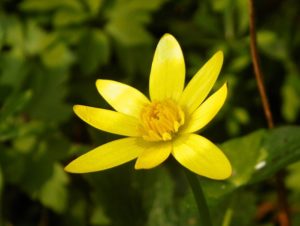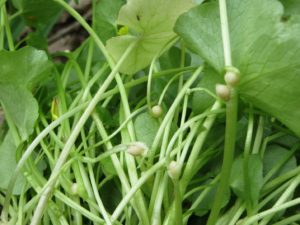By Michael Putnam, DNR invasive plants specialist (Madison), Michael.Putnam@wisconsin.gov, 608-266-7596

Lesser celandine flower. Photo: Wikimedia
Lesser celandine (Ranunculus ficaria) is an invasive forest plant that been found in urban forests in southeastern Wisconsin. The plant has a history of taking over forest floors in the eastern U. S. and crowding out native plants and tree seedlings. Consequently, lesser celandine is listed as a Prohibited Species under the state’s invasive species law NR 40, and cannot be transported, sold, introduced or possessed in Wisconsin.
DNR is undertaking control projects in Dane, Milwaukee, Racine and Kenosha counties – four of the six counties where lesser celandine is known to occur – and will be conducting surveys in the remaining two counties, Walworth and Waukesha, to inform future control efforts.

Lesser celandine with reproductive bulbils Photo: DNR photo
Lesser celandine starts growing in early spring, with bright yellow flowers appearing in April. It dies back by the end of June. This low-growing plant has shiny, waxy leaves that are kidney or heart-shaped. Small spherical bulbils that form along the stems drop off to give rise to new plants, while underground tubers sustain the plant after it dies back. Because of its short growing season, DNR depends on reports from the public to identify new populations to plan accordingly. If you encounter this plant, please report it at Invasive.Species@wi.gov.
